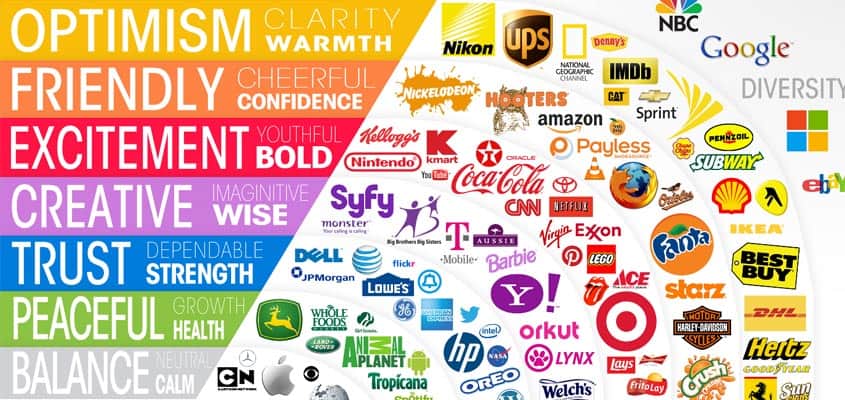How to create a brand for your business is a great question. Branding is one of the areas you should complete before starting your business.
There are several steps to go through, and I will touch on each one so that you will have the right information to create your brand.
I have also put some links at the end to some tools that can help with creating your brand.
Your long term vision might be to build a multinational company or a small local business. Either way, it’s essential that you have an identity that your customers recognise.
Most people are looking for a solution first, and whether you can provide it. Only at this point do customers think about who you are.
With the continued rise in individuals working as freelance/consultant becoming the norm. More people are making decisions about whether to create a personal or company brand.
Personal branding is selling you and your skills, and company branding is selling your combined expertise.
Side note: some will say that a brand guideline when starting a business is not essential. There is also the fact that new customers of your company won’t look at your brand first.
I have covered how to carry out market research and how to create a marketing strategy in other posts.
Let’s go through the steps to take to create a brand for your business.
1. Why your business should have a brand
Branding is important because everything you do when marketing starts with your brand identity, brand uniqueness, brand voice and brand mission.
Every time you present your business to the world, you are showing a unified set of values.
The more established your business, the more branding is a crucial part of your identity.
If asked, you could name at least three of your favourite brands. Also, if shown, you would recognise a lot of the top brands in the world by their logo.
So, branding is a critical element of your perception of a company. It can also create tribes such as the case with Apple, Samsung, Google and Microsoft.
Those tribes become evangelists for the brand and will promote your business at every opportunity.
2. Creating the best brand for your business
When you start the process to create a brand for your business, there are some fundamental elements to complete.
We all want the most memorable, creative, stylish and trustworthy brand we can. However, this is a balance of how you see your business and how your customers see your business.
Branding your business always starts with your customers first. Knowing your customers is knowing who they are in the world.
For instance, you would brand your business accordingly, when you are selling tools to builders or clothes to Millenials.
One would have rugged, reliable branding, and the other would have stylish lifestyle branding.
Creating your brand name
Side note: none of the top 100 global brands is descriptive.
Your brand name should be memorable and either unique such as Pepsi, identifiable such as Louis Vuitton or descriptive such as Gold’s Gym.
When creating a brand name, you also need to take into consideration how that will translate online.
For instance, when you are choosing a web name/URL. It’s no use to have a brand name such as “betty’s baked goods and sandwiches”.
No one is going to remember the website address www.bettysbakedgoodsandsandwiches.com or social media account https://facebook.com/bettysbakedgoodsandsandwiches.
So, your brand name needs to be concise and easy to remember.
In the example above, it would be better to have something like “Betty’s” or “Betty’s bakers”. And your job is to make it a strong brand.
In this instance, the brand name would be the memorable headline and the subheading message would be what you do.
Creating your brand logo
When thinking about creating a brand logo clarity and dimensions are essential.
How will it look across literature, signage and web presence? How will it fit without taking up too much room across those areas?
A vertical logo takes up the height of the available space, a horizontal logo takes up the width of the area, and a round logo takes up both.
The amount of words used has a bearing on how big the logo ends up, especially if the logo has an insignia.
Many logos use the company name and insignia and use them together or separately in different formats.
Creating your brand colours
Brand colours use psychology, as colours promote a feeling or emotion. So, red traditionally means danger when it comes to road signs. However, when it comes to a business logo, it translates as excitement, youthful and bold.
I have added a lovely image that shows a range of colours, there emotional meaning and companies that use those colours below.

The image above may have surprised you and show that recognised colours of brands are used to convey a subconscious emotion.
It’s all part of the design impact that a logo gives your business.
Creating your brand guidelines
Once you have carried out the areas above, it’s onto creating your brand guidelines. Brand guidelines are the process of creating a document that lists out what the business can and can’t do.
So it will map out what the logo looks like, where you place the logo and the size of the logo for different mediums. It finalises the logo colours that you have to follow. And, it lists any font that you use in your logo.
Another area to have finalised on your brand guidelines is your heading and content/body fonts.
So many new business owners pick a script font that looks pretty and curvy. However, it is unreadable on so many screen sizes.
It may be right on an image banner for Youtube or social media. But, as an actual font on a website it doesn’t travel well and the harder it is to read, the less likely it will be.
Be specific in your guidelines to make sure that everyone involved knows your expectations.
When anything leaves your business, whether it’s on paper or online, it should not stray from the guide.
3. Using your brand in every part of your business
Now that you have your brand and the guidelines, you can use it for every part of your business.
- your website
- social media accounts
- social media posts
- advertising
- stationery
- signage
- and anything else you use for marketing.
Branding on your website
The theme, feel, and design of your website should use your guidelines to present your brand. Also, you can use a related colour scheme to design a web page (link at the bottom of this page).
Every page header and footer should relate to your branding. The body content in between can also use your branding or related colour scheme.
This way, wherever the user navigates to on your website, it has a related recognisable brand.
Branding brick and mortar
If you have a brick and mortar store or office, your signage (even parking signs) and interior colour scheme should reflect your brand.
Branding Social Media
When it comes to your social media accounts, branding is essential when users travel back and forth to your website. They will experience a consistent branding and immediately know they are in the right place.
When you create an image for social media, depending on what the image is for it can have your branding or no branding at all.
4. Summary.
I hope that this article has delivered on my promise to you. And, you are now able to create a brand for your business.
Check out some of the links below that can help you create your brand.
- Logo Maker: https://www.canva.com/tools/logo-maker
- Logo Maker: https://www.wix.com/logo/maker
- Colour scheme picker: https://coolors.co
- Font chooser: https://fonts.google.com
- Font Chooser; https://wordmark.it
